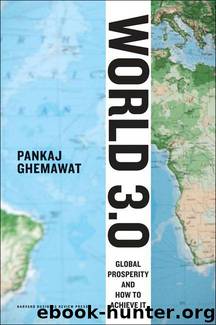World 3.0: Global Prosperity and How to Achieve It by Pankaj Ghemawat

Author:Pankaj Ghemawat [Ghemawat, Pankaj]
Language: eng
Format: epub
Publisher: Harvard Business Review Press
Published: 2011-04-25T22:00:00+00:00
Developing Concerns
Free trade enjoys stronger public support in poorer countries than in rich ones, yet that hasn't stopped intellectuals on the left from arguing that “neoliberal” free-trade agreements pursued during the last twenty or so years systematically exploit the poor.42 Why so much skepticism about globalization's benefits for poorer countries when the prevailing economic theories imply that integration promotes growth and convergence, which are obviously good for the poor? Much of the worry about globalization that exists in the developing world reflects the real exploitation that many countries suffered under colonial rule. Recall that economists believe all freely chosen transactions should be mutually beneficial. Under previous episodes of globalization, poorer countries engaged in a host of transactions that were far from freely chosen: exporting mineral resources, purchasing manufactured goods from colonial masters, and so on. With that kind of history, it's no surprise that foreign ownership of major industries might be met with some suspicion.
Let's look at what actually has happened under globalization in developing countries. Most importantly, poverty has declined markedly, as shown in figure 9-5 (top panel). The number of human beings living on less than $2 a day declined from 1.6 billion in 1970 to 850 million in 2006, even though the world population almost doubled over the same period.43 That 850 million people live on under $2 a day is a tragedy, but claims that the integration of the last few decades harmed the poor just don't fit the facts. Skeptics argue that graphics like figure 9-5 focus on gains in big countries like China and overlook smaller countries that have done poorly. Actually, many (though not all) smaller economies are also benefiting. Think of the growth of commodity producers, particularly in Africa, fueled by China's rise.
Rising inequality within many developing countries is also a concern. This trend might seem surprising based on trade theory, but scholars have tied it to shifts toward more technologically advanced exports along with domestic developments like urbanization.44 Back in 1955, Simon Kuznets famously linked early stages of economic development to rising inequality,45 though subsequent research has cast doubt on that relationship.46
Consider China's changing income distribution (bottom of figure 9-5). Before what Chinese leaders call the “period of reform and opening up” began in 1978, China had very little inequality and a lot of poverty (the vertical lines on the graph show the poverty line at only $1 per day). But as China's leader at the time, Deng Xiaoping, explained, “Some people will become prosperous first, and then others will become prosperous later.”47 China is now much less equal than thirty years ago, but the country has nearly eradicated poverty at the $1 a day level. And recent data indicate that Chinese inequality may be starting to decline with the government's emphasis on building a “harmonious society.”48
Figure 9-5: World poverty rate at $1/2/3/5 per day versus exports as percent of GDP (top) and China's income distribution (1970–2006) (bottom)
Sources: Poverty rates and Chinese income distribution from Maxim Pinkovskiy and Xavier Sala-i-Martin, “Parametric
Download
This site does not store any files on its server. We only index and link to content provided by other sites. Please contact the content providers to delete copyright contents if any and email us, we'll remove relevant links or contents immediately.
| Elections & Political Process | Ideologies & Doctrines |
| International & World Politics | Political Science |
| Public Affairs & Policy | Specific Topics |
| United States |
The Secret History by Donna Tartt(16705)
The Social Justice Warrior Handbook by Lisa De Pasquale(11501)
Thirteen Reasons Why by Jay Asher(7824)
This Is How You Lose Her by Junot Diaz(5818)
Weapons of Math Destruction by Cathy O'Neil(5068)
Zero to One by Peter Thiel(4858)
The Myth of the Strong Leader by Archie Brown(4805)
Promise Me, Dad by Joe Biden(4467)
Beartown by Fredrik Backman(4457)
How Democracies Die by Steven Levitsky & Daniel Ziblatt(4439)
Stone's Rules by Roger Stone(4434)
The Fire Next Time by James Baldwin(4363)
100 Deadly Skills by Clint Emerson(4103)
A Higher Loyalty: Truth, Lies, and Leadership by James Comey(4051)
Rise and Kill First by Ronen Bergman(4036)
The David Icke Guide to the Global Conspiracy (and how to end it) by David Icke(3908)
The Farm by Tom Rob Smith(3890)
Secrecy World by Jake Bernstein(3800)
The Doomsday Machine by Daniel Ellsberg(3747)
